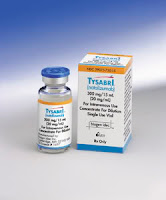An
intriguing new study suggests that low body mass may be associated with
an increased risk for developing progressive multifocal
leukoencephalopathy (PML) in the setting of therapy with natalizumab
(Tysabri, Biogen Idec) for multiple sclerosis (MS). "Higher PML
incidence definitely trends toward lower body weights," said John Foley,
MD, a neurologist at Rocky Mountain Multiple Sclerosis Clinic, Salt
Lake City, Utah. There is about a 54% excess in PML cases in Europe
Union compared with expected cases based on percentage of world-wide
use, Dr. Foley pointed out.
Natalizumab
concentration clearly increases with time, he said, and in this study,
high natalizumab concentrations appeared to occur particularly in
patients with lower body weight. "High natalizumab saturations correlate
best to populations with both low body weight and very high drug level
per kilogram. Extended-dose therapy can decrease concentration and
saturation as you might expect, and may well be a viable therapy for PML
risk reduction."
The findings were presented here at
the American Academy of Neurology (AAN) 65th Annual Meeting. The study
was supported by Biogen Idec/Elan Pharmaceuticals.
Lower Weight, Higher Risk?
Natalizumab
is an effective treatment for MS, but the risk for PML is an important
issue, considering its use, the study abstract notes. Factors that have
already been identified as predictors of PML susceptibility include
duration of therapy and positivity for antibodies to the JC virus upon
starting therapy.
The so-called EU/US paradox in PML
cases has been described previously, he said. If cases were evenly
distributed between these regions on the basis of use, there should be
approximately 125 cases of PML in the EU. Instead, there have been 193
cases, a 54% excess over expected numbers, much of which has been
ascribed previously to an increased use of immunosuppressants in the EU,
he noted.
In this study, Dr. Foley looked at
pharmacokinetic and pharmacodynamic effects of prolonging the interval
between doses of natalizumab as a possible risk mitigation strategy
against PML.
He collected demographic and clinical data
from a cohort of 301 natalizumab-infusing patients at their clinic and
compared their data with an aggregate of such patients worldwide,
including a cohort of 38 patients with PML.
Looking at
drug concentrations, results showed a tight correlation coefficient
between drug saturation of VLA-4 lymphocytes and the concentration per
kilogram, ranging from 85% mean saturation to 95% in those with the
lowest weight. "This weight relationship was also recognized early on in
the natalizumab experience, and actually is in the PI [prescribing
information], that higher drug clearance was seen in patients with
higher body weight," Dr. Foley noted.
The researchers
then stratified saturation by both weight and concentration and found
that most patients with saturations of 90% to 95% were in the lower
weight category, but they also mapped into the higher concentration
category. "When you look at what we called our 'ultra-saturators,' our
95%-plus saturators, here you start seeing stratification into this
really high concentration and low-weight group."
On the
basis of these findings, he said, "we hypothesized that if increased
concentrations and saturations occur in low body weight populations, and
are germane to PML risk, then we should see more PML cases in patients
with lower body weight."
By collaborating with several
other centers, they were able to collect data on 38 patients with PML
(almost 12% of the reported cases associated with natalizumab treatment)
to look at the weight distribution between EU and US populations. In
this PML cohort, the median weight was 64 kg, with a mean of 70 kg
across all patients, and no significant difference was seen between the
European and US populations in weight distribution among PML cases.
However,
at their institution in Salt Lake City, Dr. Foley noted, "our median
weight is 78 kilos, 14 kg greater than the average PML case. And in
keeping with the theory, we do see in the Swedish cohort, which we are
using as a surrogate for the EU population, as being much closer to the
PML cohort at 69 kg."
They then divided patients into
weight "bins" to try and elucidate the relationship further. In their
clinic, 13% of patients fell into the 60 kg or less bin, whereas in the
Swedish population of 1127 natalizumab-treated patients, 22% fell into
the 60 kg or less bin. "And what we see is there is a striking elevation
in PML cases in that lowest-weight category, almost 3-fold different
from the US and almost 2-fold different from the combined (EU and US)
data," he said.
"The other question is then what
happens when you do dose extension, and here we're dose extending from a
standard 28 to 30 days, to a 6-week regimen," Dr. Foley concluded. They
don't yet have a lot of patients receiving this 6-week regimen, but
they saw a significant reduction in mean concentration with the 6-week
dosing cycle; in addition, saturation dropped roughly 6.5% in this small
cohort
"It's one of those observations where only time
will tell but it's certainly really fascinating," she told Medscape
Medical News. The question is, though, which came first, she points out;
lower body weight may mean the patients are healthier, or it may mean
they are more ill, and therefore more likely to get PML.
"So there are a lot of unknowns, but I think it's just fascinating," she concluded.
The
study was supported by Biogen Idec/Elan Pharmaceuticals. Dr. Foley
reports having received personal compensation for activities with Biogen
Idec, Teva Neuroscience, and Genzyme Corporation as a consultant and
research support from Biogen Idec and Novartis. Dr. Jung Henson has
received personal compensation for activities with Biogen Idec, Teva
Neuroscience, Genzyme Corporation, Novartis, and Pfizer Inc. One of her
family members holds stock and/or stock options in Merck & Co Inc.
She has received research support from Biogen Idec, Novartis, and
Genzyme Corporation.
American Academy of Neurology (AAN) 65th Annual Meeting. Abstract S30.002. Presented March 20, 2013.
